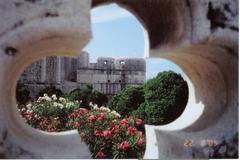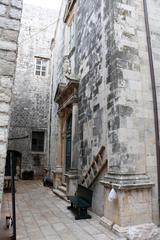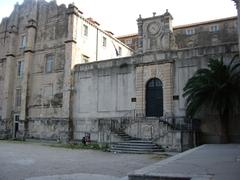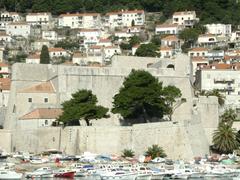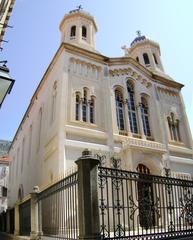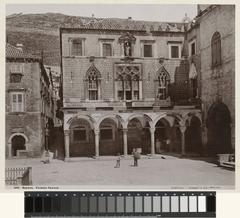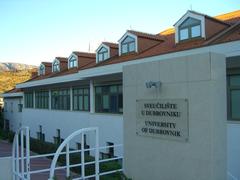
Lazzarettos of Dubrovnik: Visiting Hours, Tickets, and Historical Significance
Date: 04/07/2025
Introduction
The Lazzarettos of Dubrovnik are among the Adriatic’s most compelling historical sites, offering visitors an unparalleled perspective on the city’s legacy as a center of maritime trade, public health innovation, and cultural resilience. Originally constructed in response to devastating plagues between the 14th and 18th centuries, these quarantine complexes protected the Republic of Ragusa (modern Dubrovnik) from epidemics while sustaining its thriving economy. Today, the Lazzarettos serve as a dynamic cultural hub, seamlessly blending their storied past with contemporary arts, festivals, and community engagement (SpottingHistory; meetdubrovnik.com; tzdubrovnik.hr).
This guide details the Lazzarettos’ historical evolution, architectural features, cultural significance, and provides essential visitor information—covering hours, tickets, accessibility, and nearby attractions. Whether you are a history enthusiast, a cultural explorer, or a casual traveler, the Lazzarettos offer a unique window into Dubrovnik’s pioneering spirit.
Table of Contents
- Origins and Historical Context
- Architectural Development and Features
- Function and Public Health Impact
- Transformation and Contemporary Significance
- Visitor Information: Hours, Tickets, and Access
- Events, Festivals, and Community Engagement
- Travel Tips and Nearby Attractions
- Frequently Asked Questions (FAQ)
- Summary and Final Tips
- References
Origins and Historical Context
The Lazzarettos emerged in direct response to recurring plague outbreaks that threatened the Republic of Ragusa during the height of its maritime power (SpottingHistory). Early quarantine measures began on nearby uninhabited islands, but strategic concerns prompted authorities to relocate these facilities closer to the city, resulting in the construction of the first major lazaretto on Lokrum Island in 1533. By 1590, a more extensive complex was underway in the Ploče district, completed in 1642, and became one of the Mediterranean’s most advanced quarantine stations.
The term “lazaretto” derives from Saint Lazarus, the patron saint of lepers, and the concept of quarantine (“quaranta”) referenced the 40-day isolation period required of arriving ships, passengers, and goods. This public health initiative dramatically reduced the frequency and severity of epidemics in Dubrovnik and set a precedent for European port cities (muzej.lindjo.hr).
Architectural Development and Features
Layout and Urban Integration
Strategically positioned at the eastern entrance to the Old Town in the Ploče district, the Lazzarettos formed a literal and symbolic gateway to Dubrovnik (meetdubrovnik.com). The complex features ten elongated stone halls (naves), five interior courtyards, and two two-story houses, all constructed from local limestone between 1590 and 1642 (muzej.lindjo.hr). Courtyards provided fresh air and natural light, while wells supplied clean water—both vital for health and sanitation.
Defensive and Sanitary Innovations
The Lazzarettos were separated from the city by fortified walls and controlled gates, minimizing disease transmission. Their proximity to the sea allowed ships to offload cargo directly into quarantine, bypassing urban areas—a pioneering fusion of maritime and urban infrastructure that influenced quarantine architecture across the Mediterranean (meetdubrovnik.com).
Function and Public Health Impact
Upon arrival, merchants, travelers, and goods were isolated for 40 days. Sanitation practices included monitoring for symptoms and disinfecting goods with vinegar, sulfur, or garlic, though the efficacy was limited by modern standards (SpottingHistory). Nonetheless, the system’s effectiveness is evident: after the Lazzarettos’ establishment, major epidemics became rare. The final significant outbreak occurred in 1815–1816.
Dubrovnik’s Lazzarettos stood at the forefront of European quarantine facilities—distinguished by their scale, architectural sophistication, and integration with the city’s defensive and diplomatic systems.
Transformation and Contemporary Significance
Adaptive Reuse and Preservation
Following the Republic’s fall in 1808, the Lazzarettos continued as quarantine sites before being repurposed for military use and suffering damage in the 19th and 20th centuries. Today, extensive restoration efforts have preserved their Renaissance architecture and original layout, earning protected status as a Croatian cultural monument (muzej.lindjo.hr).
Cultural and Creative Hub
The Lazzarettos now serve as a vibrant center for culture and the arts. Two naves house the renowned Linđo Folk Ensemble, while others are dedicated to art workshops, exhibitions, and community organizations. The site hosts major festivals, concerts, food events, theatrical performances, and creative workshops (tzdubrovnik.hr; amusingplanet.com).
Visitor Information: Hours, Tickets, and Access
- Location: 300 meters east of Dubrovnik’s Old Town, near Ploče Gate (Dubrovnik Travel).
- Opening Hours: Generally open 9:00 AM–7:00 PM (April–October), 9:00 AM–4:00 PM (off-season). Event hours may extend later—check official event calendars for details.
- Admission: Courtyards and public spaces are usually free. Ticketed events (exhibitions, concerts, performances) vary from 20–150 HRK. Advance booking is recommended for popular events (Dubrovnik Summer Festival).
- Accessibility: Ramps and accessible restrooms are available; some upper levels have limited access due to historic architecture. Multilingual information and guided tours are offered, especially during festivals (tzdubrovnik.hr).
- Facilities: Restrooms, event spaces, and small cafés/bars (during events). Tourist information is available at nearby offices.
Events, Festivals, and Community Engagement
- Dubrovnik Summer Festival: Internationally acclaimed festival with music, theater, and dance performances.
- Food Festivals: Burger Fest, Foodranvanje Street Food Festival, Good Food Festival, and more.
- Light and Winter Festivals: Luminart Light Festival and Dubrovnik Winter Festival illuminate the site with creative installations and holiday events.
- Resident Groups: Linđo Folklore Ensemble, Art Workshop Lazareti, Deša humanitarian group, and Lero Student Theatre (muzej.lindjo.hr; visit-croatia.co.uk).
- Workshops and Lectures: Year-round programs focus on traditional crafts, music, local history, and community engagement.
Travel Tips and Nearby Attractions
- Combine Your Visit: The Lazzarettos are steps from the Old Town walls, Rector’s Palace, and Banje Beach. The Museum of Modern Art and the Old Port (for trips to Lokrum Island) are also nearby (Croatia Traveller).
- Best Time to Visit: Early morning or late afternoon for fewer crowds and softer light; off-peak months (May–June, September–October) for a relaxed ambiance (North Coast Croatia).
- What to Bring: Comfortable shoes, sun protection, water bottle, and camera.
- Booking: Reserve tickets for events in advance, especially during July–August (Dubrovnik Summer Festival).
- Local Etiquette: Respect restricted areas and event guidelines; dress modestly for cultural performances.
Frequently Asked Questions (FAQ)
Q: What are the Lazzarettos’ visiting hours?
A: Typically 9:00 AM–7:00 PM in high season; check event schedules for variations.
Q: Is there an entrance fee?
A: Public spaces are free; events and exhibitions may require tickets.
Q: Are the Lazzarettos wheelchair accessible?
A: Ground-level areas are accessible; some historic upper floors are not.
Q: Can I take photographs?
A: Yes, except where restricted during certain events.
Q: Are guided tours available?
A: Yes, through local tour operators and cultural organizations.
Summary and Final Tips
The Lazzarettos of Dubrovnik encapsulate centuries of innovation, resilience, and vibrant culture. From their origins as groundbreaking quarantine stations to their modern role as a cultural and creative hub, they offer a multifaceted experience for visitors. With accessible open spaces, engaging programming, and insightful guided tours, the Lazzarettos are a testament to Dubrovnik’s unique legacy in European history.
Plan ahead:
- Check current hours and event programs (tzdubrovnik.hr).
- Book tickets for festivals or performances early.
- Explore nearby attractions to enrich your visit.
For personalized cultural guides and real-time updates, consider downloading the Audiala app.
Immerse yourself in Dubrovnik’s enduring spirit at the Lazzarettos—where history and living culture meet on the Adriatic coast.
References
- SpottingHistory
- meetdubrovnik.com
- tzdubrovnik.hr
- Dubrovnik Travel
- Dubrovnik Summer Festival
- muzej.lindjo.hr
- AmusingPlanet
- visit-croatia.co.uk
- Croatia Traveller
- North Coast Croatia
- BBC Travel





